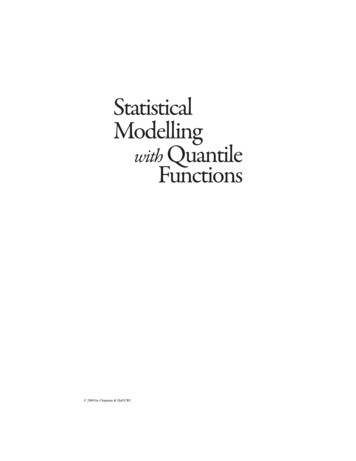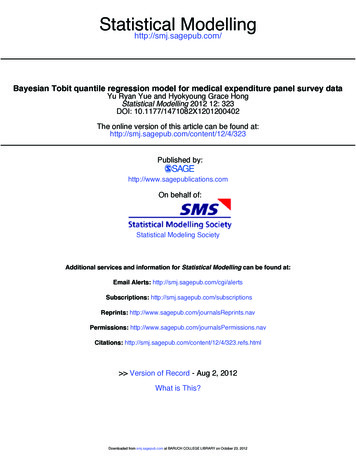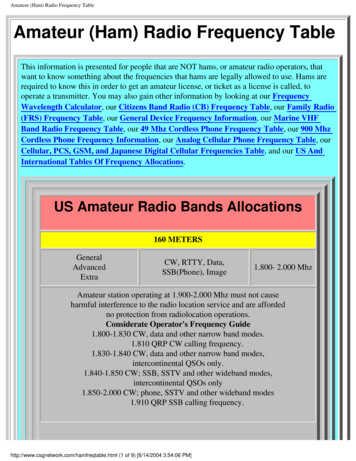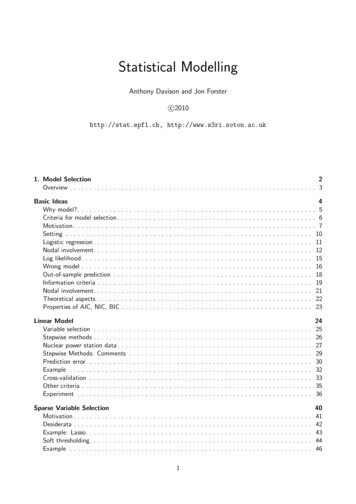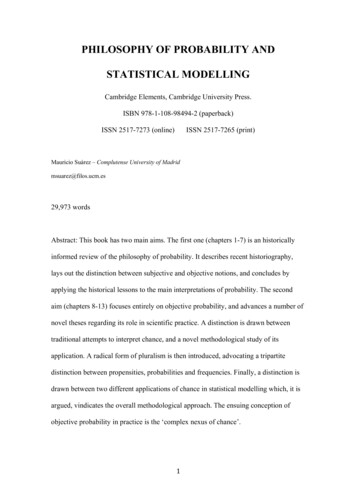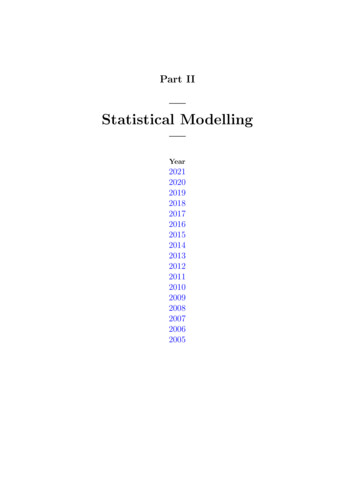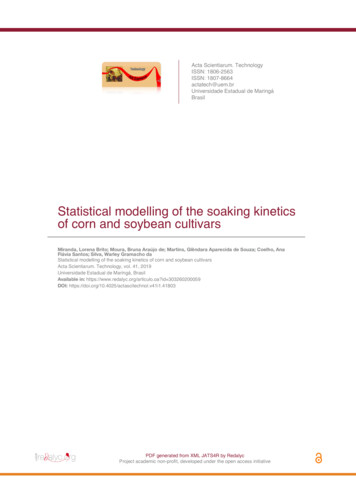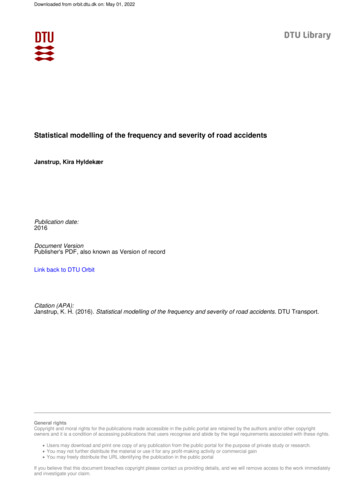
Transcription
Downloaded from orbit.dtu.dk on: May 01, 2022Statistical modelling of the frequency and severity of road accidentsJanstrup, Kira HyldekærPublication date:2016Document VersionPublisher's PDF, also known as Version of recordLink back to DTU OrbitCitation (APA):Janstrup, K. H. (2016). Statistical modelling of the frequency and severity of road accidents. DTU Transport.General rightsCopyright and moral rights for the publications made accessible in the public portal are retained by the authors and/or other copyrightowners and it is a condition of accessing publications that users recognise and abide by the legal requirements associated with these rights. Users may download and print one copy of any publication from the public portal for the purpose of private study or research. You may not further distribute the material or use it for any profit-making activity or commercial gain You may freely distribute the URL identifying the publication in the public portalIf you believe that this document breaches copyright please contact us providing details, and we will remove access to the work immediatelyand investigate your claim.
Statistical modelling of thefrequency and severity of roadaccidentsKira Hyldekær JanstrupJanuary 2016
Statistical modelling of the frequency and severity of road accidentsI
Statistical modelling of the frequency and severity of road accidentsPREFACEThis dissertation presents my Ph.D. study with the title “Statistical modelling of thefrequency and severity of road accidents” where an investigation of the underreporting of traffic accidents in Denmark is conducted. The study has been carried outat the Department of Transport at the Technical University of Denmark in the periodDecember 2009 to January 2016. The study was a part of a large research projectnamed “Improving road safety” that was financed by the Danish Research Council.First and foremost I would like to thank my supervisor Dr Sigal Kaplan for greatmotivation and inspiration. I have really enjoyed our many talks and discussions and Iam forever grateful that our paths crossed. I would also like to thank my co-supervisorProfessor Carlo G. Prato for methodology guidance and many interesting discussions.Both Sigal and Carlo’s engagement and competencies have been crucial for this studyand you both have my deepest gratitude for everything.A special thanks goes to Tove Hels and Inger Marie Bernhoft for believing in me andencouraging me to apply for a Ph.D. in traffic safety.I would like to thank Stig Hemdorf from the Danish Road Directorate for support andhelp with problems experienced with the handling of police registered traffic accidentdata. I would also thank Jens Lauritsen and the Accident Analysis Unit from OdenseUniversity Hospital for great assistance and support for the handling andunderstanding of the Danish hospital data.I would like to thank my colleagues at the Department of Transport at the TechnicalUniversity of Denmark and the people who have supported me throughout my Ph.D.study. Specifically, I would like to thank Dr Michael B. Barfod for introducing me tomulti-criteria decision analysis and the cooperation in the final article in my thesis.Finally, I would like to thank my family and friends for their support and care in thepast years. A special thanks goes to my husband for his encouragement and help,without you I would never have gone this far.Kira Hyldekær Janstrup, January 2016II
Statistical modelling of the frequency and severity of road accidentsIII
Statistical modelling of the frequency and severity of road accidentsABSTRACTUnder-reporting of traffic accidents is a well-discussed subject in traffic safety and it iswell-known that the degree of under-reporting of traffic accidents is quite high in manycountries. Nevertheless, very little literature has been made to investigate what causesthe high degree of under-reporting. The problem of under-reporting is not unique fortraffic accidents as severe under-reporting is a challenge in many other fields ofincident reporting. In other incidents fields with intended or unintended harm,research has investigated the behavioural reasons for why people choose to report anincident to the authorities. These kinds of studies have never been conducted withinthe field of transport. Furthermore, in other fields of incident reporting literature hasdocumented that distrust to the police or to other authorities has an influence on thereporting rate. Even though a few studies have focused on the service quality within thepolice none have looked at the service quality specific for the handling of trafficaccidents.The objective of this Ph.D. thesis is to investigate the extent of under-reporting of trafficaccidents in Denmark and trace the under-reporting systematically. As something newand innovative this project also explores the behavioural reasons for under-reportingby investigating the barriers associated with the intention to report a bicycle incidentin Denmark. Furthermore, the service quality within the police for the handling oftraffic accident reporting is investigated by an expert management tool.Initially models were built by using existing traffic accident data collected by the policeand emergency rooms in Denmark. The data registered by the police was collected ontraffic accidents occurred on Danish roads in the period between 2002 and 2008. Theemergency room data were collected at three hospitals located at Funen in the periodbetween 2002 and 2009. Furthermore, two large-scale questionnaires were developedand administered. The first questionnaire was administered among bicyclist inDenmark and investigates the behavioural reasons for reporting traffic accidents. Thesecond questionnaire was administered to stakeholders in the transportation field andwas made to detect strengths, threats and opportunities for reporting traffic accidentswithin the police.This Ph.D. study contributes significantly to the literature about under-reporting. Thefollowing innovative findings are presented:1) New estimates of the under-reporting in the police registered data at Funen inDenmark have been found and these numbers were found to be larger thannumbers found in other Countries (Paper 1).IV
Statistical modelling of the frequency and severity of road accidents2) As something new the heterogeneity in the reporting rate has been shown andby that recognition of the reasons for heterogeneity has been made, which inthe end may lead to devising policy measures (Paper 1).3) A connection between the occurrence probability of trauma type and crash,vehicle and person characteristics exists (Paper 2).4) The attitudes that accident reporting is useless are found to be the mostrelevant factor related to the lack of intention to report future cycling accidents.Secondly, the factors: concerns about family distress and social image andpreference to allocate time to other activities are both associated with nonreporting intentions (Paper 3).5) New information about the barriers for the intention to report a bicycleincident can help in designing policy measures for improving the reporting ratefor bicycle incidents and in that connection also the traffic safety for bicyclist(Paper 3).6) A new and innovative method is found to evaluate the service quality and istested on the handling of traffic crash reporting within the police (Paper 4).7) Improvements can be made within the police to improve the handling of trafficcrash reporting and these improvements will benefit the reporting rate themost if they are made in the dimension responsiveness (Paper 4).The thesis extends the literature about under-reporting and gives new and innovativeknowledge which can contribute to new policy measures for improving the reportingrate. For that reason this thesis should be used as an important tool wheneveraddressing the under-reporting challenge.V
Statistical modelling of the frequency and severity of road accidentsABSTRACT IN DANISH (DANSK RESUME)Mørketallet for færdselsuheld er et veldiskuteret emne inden for trafiksikkerhed og deter velkendt, at mange lande har et meget højt mørketal. Ikke desto mindre findes dermeget lidt litteratur, der beskriver grundene til de høje mørketal for færdselsuheld.Problemet med mørketal er ikke unikt for færdselsuheld, og det viser sig, at højemørketal også er et problem inden for mange andre områder med uheldsrapportering.Inden for andre områder med uheldsrapportering, både med tilsigtet og utilsigtet vold,har studier undersøgt, hvilke adfærdsmæssige grunde der får folk til at anmelde enhændelse til myndighederne. Disse typer af studier har aldrig været udført indenfortrafiksikkerhedsområdet. Inden for andre områder med uheldsrapportering har manogså påvist, at mistro til politiet og andre myndighedsinstanser har en indflydelse på,om folk vælger at anmelde en uheldshændelse. Selvom kun få studier har fokuseret påservicekvaliteten hos politiet, har ingen specifikt undersøgt politiets håndtering afanmeldelser af færdselsuheld.Formålet med denne ph.d.-afhandling er at finde mørketallene for færdselsuheld ipolitiets register i Danmark og spore systematikken i mørketallene. Som noget helt nytog innovativt undersøger denne afhandling også, hvilke adfærdsmæssige grunde der ertil, at cyklister i Danmark vælger at anmelde deres cykelhændelse/-uheld tilmyndighederne. Dette gøres ved at undersøge, hvilke barrier der har indflydelse påcyklistens hensigt om at anmelde en cykelhændelse. Afslutningsvis bliverservicekvaliteten af håndteringen af færdselsuheldsanmeldelser hos politiet ogsåundersøgt, og her er et nyt redskab til at evaluere servicekvaliteten blevet fundet oganvendt på det konkrete problem.Den første del af afhandlingen anvender matematiske modeller på eksisterendefærdselsuheldsdata registreret af politiet og skadestuerne i Danmark. Data indsamlet afpolitiet indeholder alle færdselsuheld, som er anmeldt til politiet i perioden 2002 til ogmed 2008, og indbefatter de færdselsuheld, som fandt sted på offentlige veje iDanmark. Data indsamlet på skadestuerne indeholder alle færdselsuheld anmeldt tilskadestuerne på Fyn i perioden 2002 til 2009. Den anden del af afhandlingen anvenderdata indsamlet via to store spørgeskemaundersøgelser. Det første spørgeskemahenvender sig til cyklister i Danmark og undersøger de adfærdsmæssige grunde til atanmelde en cykelhændelse til myndighederne. Det andet spørgeskema klarliggerstyrker, trusler og muligheder for håndtering af færdselsuheldsanmeldelser hospolitiet.Denne ph.d.-afhandling bidrager signifikant til den eksisterende litteratur vedrørendemørketal for færdselsuheld, hvor følgende innovative hovedresultater præsenteres:VII
Statistical modelling of the frequency and severity of road accidents1) Mørketallet for de af politiet registrerede færdselsuheld på Fyn er blevet fundetog er større end de værdier, der er fundet i andre lande (Artikel 1).2) lsuheldsregistreringen, og derved anerkendes grundene forheterogenitet i registreringen, som kan lede til misvisende politiskeanbefalinger (Artikel 1).3) Det er blevet påvist, at der er sammenhæng mellem specifikke traumatyper fortrafikanter involveret i et færdselsuheld og forskellige færdselsuhelds- ogpersonkarakteristika (Artikel 2).4) Det blev påvist, at holdningen om at cykeluheldsrapportering er nytteløs erden mest relevante faktor for manglende rapportering. Efterfølgende er de mestrelevante faktorer bekymring for, at det vil skabe uro i familien og skade enssociale omdømme og at foretrække at bruge tiden på andre ting (Artikel 3).5) Den nye information vedrørende barriererne for rapportering afcykelhændelser kan hjælpe med at udforme nye politiske målsætninger forderved at forbedre cykeluheldsregistreringen og ikke mindst trafiksikkerhedenfor cyklister (Artikel 3).6) Der er blevet udviklet en ny og nyttig metode til bl.a. at evaluereservicekvaliteten for håndteringen af færdselsuheldsanmeldelser hos politiet(Artikel 4).7) Det er blevet påvist, at der kan gemmeføres tiltag for at forbedrefærdselsuheldsregistreringen i Danmark, og at disse forbedringer vil havestørst indflydelse på antallet af rapporterede færdselsuheld, hvis de bliver lavetinden for dimensionen ansvarlighed (Artikel 4).Afhandlingen bidrager til den eksisterende litteratur omkring mørketal forfærdselsuheld og giver ny og innovativ viden, som kan bidrage til nye politiskemålsætninger for at øge antallet af færdselsuheldsregistreringer. Derfor er denneafhandling et vigtigt redskab, når problemerne omkring mørketal indenforfærdselsuheldsrapportering skal løses.VIII
TABLE OF CONTENT1INTRODUCTION .11.1ANALYSING ROAD CRASH DATA . 11.2UNDER-REPORTING . 21.2.1 Road Crash data . 21.2.2 Other incident data . 31.3AIM AND CONTRIBUTION . 41.4STRUCTURE OF THE THESIS . 52DATA .72.1POLICE REGISTER . 72.2ER REGISTER . 82.3COMBINING THE POLICE AND ER DATA . 92.3.1 Matching of data sources . 92.3.2 Data cleaning . 102.4LARGE-SCALE SURVEY AMONG YOUNG CYCLIST . 112.4.1 Survey design . 112.4.2 Survey administration . 122.5LARGE-SCALE SURVEY AMONG TRANSPORT PRACTITIONERS . 122.5.1 Survey design . 122.5.2 Survey administration . 133THEORY AND METHODS . 153.13.23.33.43.53.63.74CAPTURE-RECAPTURE . 15DISCRETE CHOICE MODELS. 16THEORY OF PLANNED BEHAVIOUR . 18STRUCTURAL EQUATION MODELS. 18SERVQUAL . 19MULTI-CRITERIA DECISION ANALYSIS. 19LATENT CLASS ANALYSIS. 20PH.D. PROJECT . 234.1PAPER 1 . 234.1.1 Description . 234.1.2 Findings . 244.2PAPER 2 . 254.2.1 Description . 254.2.2 Findings . 254.3PAPER 3 . 254.3.1 Description . 264.3.2 Findings . 264.4PAPER 4 . 274.4.1 Description . 274.4.2 Findings . 28
Statistical modelling of the frequency and severity of road accidents5FINDINGS AND DISCUSSIONS . 296CONCLUSION AND PERSPECTIVES . 33REFERENCES . 35APPENDIX . 41PAPER 1 . 73PAPER 2 . 89PAPER 3 . 103PAPER 4 . 127X
Statistical modelling of the frequency and severity of road accidents1 INTRODUCTION1.1 ANALYSING ROAD CRASH DATAEstimates have shown that 1.24 million road users die every year on the world’s roads,and another 20 to 50 million sustain non-fatal injuries as a result of road traffic crashes(WHO, 2013). Traffic safety is a societal issue and all over the world guidelines aremade in an attempt to improve traffic safety and thereby decrease the high fatality andinjury numbers. Traffic safety is described as the science providing methods (and/ormeasures) to reduce the number of fatalities and injured road users in traffic accidents.The first known traffic accident with a petrol-engine car was in 1896, where the firstknown pedestrian died. In Denmark, the data registration of traffic accidents started inthe 1930’s and was initially collected by Statistics Denmark. In 1934, 100,000 cars wereregistered in Denmark and 14,000 traffic accidents were registered with 251 fatalities,3,887 severe injured and 3,573 slightly injured road users. The highest number oftraffic accidents in Denmark was in 1971, were 1,213 road users was fatally injuredand another 27,587 injured. After this year a lot of rules were proposed to give bettertraffic safety (e.g. speed limit, seat belt, helmet). The Danish Road Directorate wasestablished in 1949 and in 2003 they took over the handling of traffic accident datafrom Statistics Denmark. Among others, this was done to get a closer dialog with thepolice who was responsible for collecting the records. The goal for fatalities and injuredroad users in road crashes in 2012 on Danish roads were set to 200 persons fatallyinjured, 1,850 severely injured and 2,100 slightly injured (Færdselssikkerhedskommissionens reviderede handlingsplan for perioden 2007-2012). Afterwards,National statistics from the Danish Road Directorate have shown that the goal was metfor fatalities and slightly injured road users in 2012, but with 1,952 severe injuredsome efforts still have to be made on the area. At the same time, it is known worldwidethat road crash databases often suffer from a high degree of under-reporting. A broadbody of research has been made on the subject and even questioned the reliability ofroad crash data collected by the police (Elvik & Mysen, 1999; Farmer, 2003; McDonaldet al., 2009). Severity and frequency models are often estimated on road crash datawithout consideration of the under-reporting phenomenon. However, in the last decadesome more advanced models (e.g. Mixed logit, Nested logit, multinomial logit) havebeen used for severity and frequency modelling of traffic accidents (Haleem & AbdelAty, 2010; Geedipally et al., 2011; Malyshkina & Mannering, 2009; Kaplan & Prato,2012) instead of the previous used Poisson regression and basic statistics (Shankar etal., 1997; Shankar et al., 1995; Lindqvist, 1991). These models prevent some of themany biases in traffic accident data (e.g. over- and under-dispersion, low sample sizeand mean) but not until recently these models have also been used to test whether ornot they catch the huge under-reporting (Patil et al., 2012; Ye & Lord, 2011). In thestudy of Ye and Lord (2011) they concluded that neither of the models tested in theirstudy (e.g. Multinomial Logit, Ordered Probit, and Mixed Logit) were immune to thechallenge with under-reporting. Nested logit models seem to be even more vulnerable1
Statistical modelling of the frequency and severity of road accidentswhen used on data which suffer from under-reporting. Recently, a study of Patil et al.(2012) has solved some of the problems but concluded that more testing is needed. So,even though advanced models find solutions to some of the problems with the hugedegree of under-reporting, a lot of work and investigation is still needed in this area tominimize the problem.1.2 UNDER-REPORTINGThe problem of under-reporting is not unique to traffic accidents and severe underreporting is present in many other incident fields (Probst & Graso, 2013; Fraas et al.,2014; Kääriäinen & Siren, 2011). The reporting problems have been addressed indifferent ways: (i) looking at multiple data sources, (ii) investigating behaviouralreasons for reporting, (iii) evaluating service quality within authorities.1.2.1 Road Crash dataThe degree of under-reporting for traffic accidents is quite high in many countries, notonly in low and middle-income countries (Abegaz et al., 2014) but also for high-incomecountries (Amoros et al., 2007; Reurings & Stipdonk, 2011; Martinez et al., 2012). InScandinavia, the problem also exists and in a meta-study on incomplete accidentreporting conducted by Elvik and Mysen (1999) the huge challenge was documented.Here they found that in Denmark only 21% of the estimated number of injured roadusers in traffic accidents is caught in the police recorded data. An ample body ofresearch has shown that the highest degree of under-reporting is found amongvulnerable road user (i.e. pedestrian, bicyclist, motorcyclist, moped users) (Elvik &Mysen, 1999; Sciortino et al., 2005; Yannis et al., 2014; Watson et al,. 2015). InDenmark, 17,500 cyclists seek medical care at emergency rooms every year, but only10% of the cyclist accidents reported to the hospital have been recorded in the officialaccident data collected by the police (Elvik & Mysen, 1999). For light injuries and solocyclist accidents (Kaplan et al., 2014) the degree of under-reporting gets even worse.The main public health challenge is the safety concerns connected with cycling andeven though National statistics are often used to identify the factors underlying cyclingaccident frequency and severity, these studies are often limited to focus on bicycleaccidents with motorized vehicles (e.g. Bíl et al., 2010; Klop, 1999; Kim, 2007).Recent studies provide evidence that under-reporting is not randomly distributedamong accident types but instead suffers from a selection bias (Amoros et al., 2007;Abay, 2015). The differences in data reported to police and/or hospital have only beeninvestigated completely with severity degree and transport mode in mind. Very littleliterature has focused on some of the more social dependent variables such as gender,age and education (Stutts, 1990; Loo & Tsui, 2007; Watson et al., 2015) and even thesestudies point in opposite directions. More information on the difference betweenhospital and police reported data could be found, for example by using trauma type,and some studies have shown great potentials of knowing trauma type (Al-Momani,1998; Adams, 2003; Martin et al., 2008). However, many of these studies have onlyfocused on a small group of trauma (e.g. fatal, head injuries).2
Statistical modelling of the frequency and severity of road accidentsEven though hospital and police data are matched and used as a common source, anunknown number of road crashes are not reported to any of the authorities. Only a verylimited amount of literature has focused on the area of none reported road crashes andthe reason of this. In France, looking at the reasons people states for not reporting theiraccidents suggests that distrust in the police and reporting usefulness plays a role(Amoros et al., 2007). Nevertheless, the relationship between the choice to report anaccident and human and social factors has never been systematic explored. Theproblem with under-reporting could be due to human and social factors as stated inAmoros et al. (2007), but it could also be because of the reporting procedure. Studieshave tended to neglect an investigation or discussion of the advances and limitations inthe way road crash data are collected. Therefore, while there exists some evidence ofthe relation between accident under-reporting, demographic variables and accidentcharacteristics, there exists little or no information of the psychological and sociologicalfactors underlying accident under-reporting.1.2.2 Other incident dataNotably, the under-reporting challenge is not unique to traffic accidents, but it is rathera more general problem concerning incidents involving both unintended and intendedharm. Severe under-reporting of a magnitude similar to traffic accidents has beenobserved also for incidents involving unintended harm such as work-related accidents(e.g., Probst & Graso, 2013) and sports injuries (e.g., Westman et al., 2010; Fraas et al.,2014). Severe under-reporting has been documented also for incidents involvingintended harm, namely crime reporting with or without seeking medical help (e.g.,Jones et al., 2009; Kääriäinen & Siren, 2011; Leshem et al., 2015). A broad sample ofliterature can be found on incidents reporting and about the psychological andsociological factors underlying the reporting. The Theory of Planned Behaviour (TPB)(Ajzen, 1991) has been used to discover these. The traditional TPB states that attitudes,social norms and perceived behavioural control are associated independently with thereporting intention. The TPB construct has among others been used to find factorsinfluencing nursing staffs reporting intention on child abuse, pharmacists’ intentions toreport drug events and hockey players’ reporting intention about concussion (Gavazaet al. 2011; Ben Natan et al. 2012; Kroshus et al. 2014). In the maritime transport andhealth-care sector, an important motivator for incident reporting is stated as the beliefthat incident reporting is useful for organizational learning, insight contribution andsafety improvement achievement (Kongsvik et al., 2012; Lindsay et al., 2012). Thesestudies and others also cite time constraints as major barriers to incident reporting,even in the case of severe consequences, because incident reporting systems areperceived as time-consuming to complete (Kongsvik et al., 2012; Lindsay et al., 2012;Williams et al., 2013; Winswold Prang & Jelsness-Jørgensen, 2014). The issue of socialnorms and their influence on reporting has been addressed for reporting of violentincidents and sports injuries (Kroshus et al., 2015; Leshem et al., 2015). Here, it hasbeen found that lack of support from family and friends, feelings of guilt and shame,fear of family distress, perceived social image, and peer-pressure are associated withunder-reporting. Distrust in the police was mentioned as a severe impeding factor toincident reporting in studies involving domestic violence and sexual assault (Jones et3
Statistical modelling of the frequency and severity of road accidentsal., 2009). Also, institutional trust was recently associated with attitudes regarding theusefulness of e-government services (Ozkan & Kanat, 2011). Last, a recent studyshowed that police distrust along with high societal trust is related to a low crimereporting rate (Kääriäinen & Siren, 2011). For that reason, there has been an increasedfocus on distrust and perceived
Statistical modelling of the frequency and severity of road accidents Janstrup, Kira Hyldekær Publication date: 2016 Document Version Publisher's PDF, also known as Version of record Link back to DTU Orbit Citation (APA): Janstrup, K. H. (2016). Statistical modelling of the frequenc

